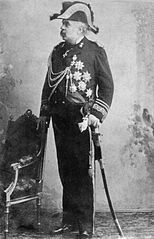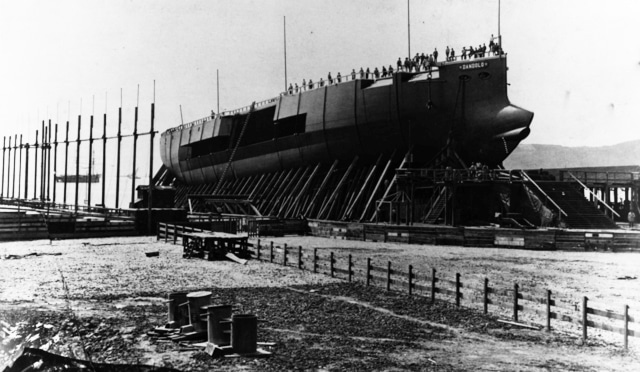A concentrate of innovations:
Caio Duilio was the lead ship of the namesake class of ironclad turret ships, built for the Italian Regia Marina in the 1870s. The name recalled Roman Admiral Gaius Duilius. The Duilio was started in January 1873, launched in May 1876, and completed in January 1880. The class also comprised the Dandolo, and both replaced the sail and steam Principe Amedeo-class ironclads (1865), both missed the battle of Lissa. The Duilio class was designed by Cuniberti, and the first Italian steam-only ones. Strategically, they fitted with Italy’s large naval expansion program pitted against Austria, compounded by new possibilities offered by the opening of Suez Canal in 1869.

Blueprint of the Duilio, showing the short and concentrated “all or nothing” armour scheme.
The most powerful artillery in the world
The centerpiece of this Ironclad was a main battery of four 17.7-inch (450 mm) guns, then the largest ever put on a ship afloat worldwide. The following classes Italia class, (designer Benedetto Brin) were laid down in 1876, and the Ruggiero di Lauria class, (designed by Giuseppe Micheli), in 1880, all kept a powerful, unmatched heavy artillery. Originally the design was intended to carry Armstrong 35 t muzzle-loading guns. However the plans were modified several times during the lengthy construction, and eventually the largest guns that Armstrong produced, next to 60 t (59 long tons; 66 short tons) has been envisioned, but the choice fall ultimately on to the 100-long-ton (102 t) 450 mm gun proposed by the firm.

The two turrets were placed en echelon amidships. The Armstrong guns fired a 1,905-pound (864 kg), shell at a muzzle velocity of 1,490 (to 1,670 feet per second or 450 to 510 m/s) with varying propellant charge. Rate of fire was one per fifteen minutes. This slow rate was due to handling of the large size of the guns and propellants. The ships also carried three 14 in (360 mm) torpedo tubes, each holding a 125 kg (276 lb) warhead with a 600 m (2,000 ft) range.
Modifications
In 1890, Caio Duilio received three 4.7 in (120 mm) 40-caliber guns, each firing a 36 lb (16 kg) shell at 2,854 ft/s (870 m/s), and in 1900, two 75 mm (3.0 in) guns, eight 57 mm (2.2 in) Nordenfelt 40-caliber quick-firing guns, and four 37 mm (1.5 in) 20-caliber revolver cannon were also added to deal with TBs.
Enrico Dandolo was rebuilt later, in 1895–1898, and received four 10 in (250 mm) 40-caliber QF guns as main armament. They fired a 494.3 lb (224.2 kg) armor-piercing shell at 2,460 ft/s (750 m/s). Secondary battery consisted of five 4.7 in (120 mm) 40-caliber guns, sixteen 57 mm (2.2 in) QF guns, eight 37 mm (1.5 in) Hotchkiss revolver cannon, and four machine guns.
Design
 She was still capable of a top speed of around 15 kn (28 km/h; 17 mph). Both ships had a small superstructure forward, including the conning tower and a funnel, connected via a hurricane deck to a central military mast and aft superstructure, joining the second funnel. First ironclads in any navy to get rid of sails they had a crew of 420 officers and men (later 515). Both carried a number of smaller boats, but Caio Duilio also had a compartment in her stern, to house a small torpedo boat of the 26.5 t Clio class. This also was unique at that time. This gave an additional “torpedo range” well beyond the range of artillery. This TBD could also perform reconnaissance missions.
She was still capable of a top speed of around 15 kn (28 km/h; 17 mph). Both ships had a small superstructure forward, including the conning tower and a funnel, connected via a hurricane deck to a central military mast and aft superstructure, joining the second funnel. First ironclads in any navy to get rid of sails they had a crew of 420 officers and men (later 515). Both carried a number of smaller boats, but Caio Duilio also had a compartment in her stern, to house a small torpedo boat of the 26.5 t Clio class. This also was unique at that time. This gave an additional “torpedo range” well beyond the range of artillery. This TBD could also perform reconnaissance missions.
The armour was forged by French firm Schneider-Creusot. There was a steel belt armor 21.5 in (550 mm) thick at its strongest section, protecting the ship’s magazines, and machinery spaces. Central citadel and gun turrets received had nickel steel armor. Transverse bulkheads were installed, 15.75 in (400 mm) thick. The armored deck was 1.1 to 2 in (28 to 51 mm). Gun turrets had 17 in steel plate, but Enrico Dandolo’s new turrets (1898) had only 8.8 in (220 mm). The bow and stern were left unarmored, but they subdivided into a cellular “raft” to keep the ship for flooding. In fact this was a radical solution for the time as armour only protected the ships’s engines and ammunition magazines.
This “all of nothing” configuration sparked controversy when Royal Navy Edward James Reed visited the ships under construction. The new Italian Minister of the Navy, Simone Pacoret di Saint-Bon, replied during a Parliament session that such flooding event was very unlikely, as it needed all the bulkheads of the watertight compartments being HS.
Propulsion system comprised two vertical compound steam engines. Each drove a single screw propeller, and was fed by eight coal-fired, rectangular boilers, in two groups, forward and aft. Each trunked into a single large funnel. Top speed was 15.04 knots (27.85 km/h; 17.31 mph) at about 5,750 kW. New engines were installed in her 1895–98 refit, slightly more powerful, (top speed of 15.6 knots) and 8,045 ihp (5,999 kW). Range was 3,760 nautical miles (6,960 km; 4,330 mi) at 10 knots (19 km/h; 12 mph).

Ironclad Dandolo
This Italian Ironclad was named after the 42nd Doge of Venice. The ship was laid down at La Spezia on 6 January 1873 and launched on 10 July 1878.
Its design was similar to the Duilio, with similar armour, configuration, and powerplant made of two vertical compound steam engines each driving a single screw propeller. Its first assignation were the annual fleet maneuvers of 1885, in which it served as the flagship of the 1st Division, “Western Squadron”, under command of Vice Admiral Martini. This exercise took place off Sardinia with an attacking Sqn and a defending “Eastern Squadron”, in a Franco-Italian war scenario.

This was followed by the 1888 fleet maneuvers, and the ship was later flagship of the 3rd Division of the Active Squadron for the 1893 exercises. There was a full reconstruction (1895-1898) to a new design under Inspector Engineer Giacinto Pulino supervision. The major upgrade consisted in the addition of quick-firing 10 in (250 mm) guns (in replacement to the former 450 mm battery), and she received a new secondary battery. A new engine was also fitted, but performances stayed the same.
In 1901, Enrico Dandolo joined in the 2nd Division. It was in the Active Squadron in 1902, with Andrea Doria, Francesco Morosini, three Re Umberto-class ironclads, and the new pre-dreadnought Ammiraglio di Saint Bon. In 1905 she was transferred to the Reserve Squadron, and later versed to the Gunnery School as a training ship. In the 1911-12 Italo-Turkish war, She was versed to the 5th Division of the Italian fleet (ironclads Italia and Lepanto) but saw no action. In 1913 she was sent as a guardship at Tobruk, Libya, and transferred to Brindisi and then Venice during the war. She was eventually stricken on 23 January 1920 and later sold for scrap.

Ironclad Dandolo full steam, in sea trials, 1890s.

Details of the Duilio’s central battery
Active carrer
Caio Duilio’s career was uneventful, spending her first two decades with the Active and Reserve Squadrons, in charge of training maneuvers and exercises. The Ironclad was withdrawn in 1902 and only employed later as a training ship, until 1909. At that time she was converted into a floating oil tank, renamed GM40. Its ultimate fate is unknown.
Links
Duilio class on Wikipedia
About the Caio Duilio
About Benedetto Brin
Specs Conway’s all the world fighting ships 1860-1905.
Duilio class Ironclads specifications |
|
| Dimensions | Lenght 109.16 m (358 ft 2 in), Beam 19.74 m (64 ft 9 in), Draft 8.31 m (27 ft 3 in) |
| Displacement | 10,962 long tons (11,138 t), 12,071 t FL |
| Crew | 420 |
| Propulsion | 1 screw, Two compound steam engines, 8 boilers, 7700 hp, |
| Speed | 15.04 knots (27.85 km/h; 17.31 mph) |
| Range | 3,760 nmi (6,960 km) at 10 kn (19 km/h; 12 mph) |
| Armament | 2×2 450 mm, 3 × 14 in (360 mm) TT. |
| Armor | Belt armor: 21.5 in (550 mm), Turrets: 17 in (430 mm), Deck: 1.2 to 2 in (30 to 51 mm) |


 Latest Facebook Entry -
Latest Facebook Entry -  X(Tweeter) Naval Encyclopedia's deck archive
X(Tweeter) Naval Encyclopedia's deck archive Instagram (@navalencyc)
Instagram (@navalencyc)





 French Navy
French Navy Royal Navy
Royal Navy Russian Navy
Russian Navy Armada Espanola
Armada Espanola Austrian Navy
Austrian Navy K.u.K. Kriegsmarine
K.u.K. Kriegsmarine Dansk Marine
Dansk Marine Nautiko Hellenon
Nautiko Hellenon Koninklije Marine 1870
Koninklije Marine 1870 Marinha do Brasil
Marinha do Brasil Osmanlı Donanması
Osmanlı Donanması Marina Do Peru
Marina Do Peru Marinha do Portugal
Marinha do Portugal Regia Marina 1870
Regia Marina 1870 Nihhon Kaigun 1870
Nihhon Kaigun 1870 Preußische Marine 1870
Preußische Marine 1870 Russkiy Flot 1870
Russkiy Flot 1870 Svenska marinen
Svenska marinen Søværnet
Søværnet Union Navy
Union Navy Confederate Navy
Confederate Navy Armada de Argentina
Armada de Argentina Imperial Chinese Navy
Imperial Chinese Navy Marinha do Portugal
Marinha do Portugal Mexico
Mexico Kaiserliche Marine
Kaiserliche Marine 1898 US Navy
1898 US Navy Sovietskiy Flot
Sovietskiy Flot Royal Canadian Navy
Royal Canadian Navy Royal Australian Navy
Royal Australian Navy RNZN Fleet
RNZN Fleet Chinese Navy 1937
Chinese Navy 1937 Kriegsmarine
Kriegsmarine Chilean Navy
Chilean Navy Danish Navy
Danish Navy Finnish Navy
Finnish Navy Hellenic Navy
Hellenic Navy Polish Navy
Polish Navy Romanian Navy
Romanian Navy Turkish Navy
Turkish Navy Royal Yugoslav Navy
Royal Yugoslav Navy Royal Thai Navy
Royal Thai Navy Minor Navies
Minor Navies Albania
Albania Austria
Austria Belgium
Belgium Columbia
Columbia Costa Rica
Costa Rica Cuba
Cuba Czechoslovakia
Czechoslovakia Dominican Republic
Dominican Republic Haiti
Haiti Hungary
Hungary Honduras
Honduras Estonia
Estonia Iceland
Iceland Eire
Eire Equador
Equador Iran
Iran Iraq
Iraq Latvia
Latvia Liberia
Liberia Lithuania
Lithuania Mandchukuo
Mandchukuo Morocco
Morocco Nicaragua
Nicaragua Persia
Persia San Salvador
San Salvador Sarawak
Sarawak Uruguay
Uruguay Venezuela
Venezuela Zanzibar
Zanzibar Warsaw Pact Navies
Warsaw Pact Navies Bulgaria
Bulgaria Hungary
Hungary

 Bundesmarine
Bundesmarine Dutch Navy
Dutch Navy Hellenic Navy
Hellenic Navy Marina Militare
Marina Militare Yugoslav Navy
Yugoslav Navy Chinese Navy
Chinese Navy Indian Navy
Indian Navy Indonesian Navy
Indonesian Navy JMSDF
JMSDF North Korean Navy
North Korean Navy Pakistani Navy
Pakistani Navy Philippines Navy
Philippines Navy ROKN
ROKN Rep. of Singapore Navy
Rep. of Singapore Navy Taiwanese Navy
Taiwanese Navy IDF Navy
IDF Navy Saudi Navy
Saudi Navy Royal New Zealand Navy
Royal New Zealand Navy Egyptian Navy
Egyptian Navy South African Navy
South African Navy






























 Ukrainian Navy
Ukrainian Navy dbodesign
dbodesign